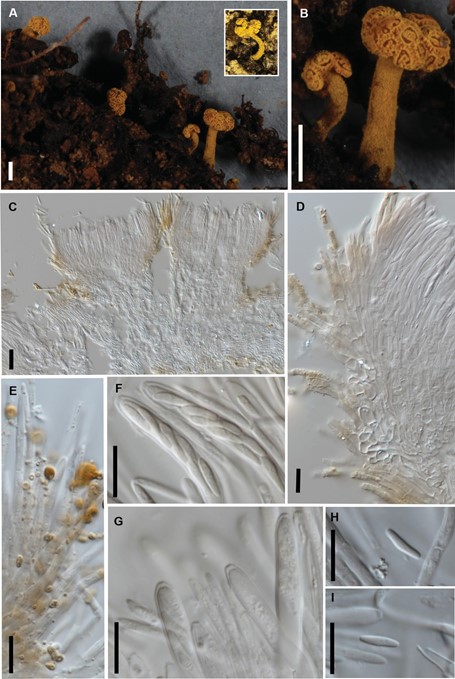Brahmaculus moonlighticus P.R.Johnst. sp. nov.
MycoBank number: MB 838733; Index Fungorum number: IF 838733; Facesoffungi number: FoF 13899; Figure 4
Typification. New Zealand – Buller • Moonlight Creek; -42.2713, 171.4587; on soil under Nothofagaceae; A. Chinn leg.; 10 May 2018; PDD 112225 – holotype.
Etymology. From the type locality. Historically important as a gold mining area (where T.H. Chinn, the great-great grandfather of the collector of the type specimen, prospected for gold in the 1880’s), the name also reflects the deep golden colour of the apothecia of this fungus.
Diagnosis. Phylogenetically distinct from other known Brahmaculus spp., apothecia 1.5–3 × 1–1.8 mm, paraphyses taper slightly to rounded apex, ascospores 6.5–8.5 × 1.5–2(–3) µm (average 7.7 × 1.9 µm).
Description. Apothecia 1.5–3 mm high, stipe 0.25–0.5 mm wide, cap 1–1.8 mm wide, bright golden-yellow when fresh, consistently with four short branches arising from top of stipe, each branch with its own apothecial cup, hymenium pale yellow, divided into a complex pattern with hymenial areas separated by narrow groups of golden yellow hair-like elements. Receptacle densely covered with stiff, bright yellow hairs. Hairs 40–60 × 3–4 µm, straight, cylindric, tapering slightly towards rounded apex, pale brown vacuolar pigment, wall smooth, encrusted with coarse yellow-brown crystals that dissolve in KOH + Melzer’s, few-septate. Ectal excipulum comprising long-cylindric cells 15–25 × 3–5 µm, but with the outermost 1–2 layers of cells short and broad-cylindric, 6–8 µm diam., cell walls slightly thickened, hyaline, cells near base of hairs with pale brown vacuolar pigment. Medullary excipulum comprising partly tangled hyphae 3–4 µm diam. with walls thin, hyaline. Paraphyses 2–3 µm diam., tapering slightly towards rounded apex, about same length as asci. Asci 45–55 × 5.5–6 µm, cylindric, tapering slightly to broad subtruncate apex, wall uniformly thickened across apex, amyloid pore extending through wall, flaring slightly towards both inside and outside of wall. Ascospores 6.5–8.5 × 1.5–2 (–3) µm (average 7.7 × 1.9 µm, n = 50), oblong-elliptic to subfusoid, sometimes tapering suddenly to a narrower lower half, ends rounded, flat one side in side view, sometimes slightly curved or sigmoid, 0-septate, hyaline.
Notes. Brahmaculus moonlighticus has a stipe that consistently has 4 distinct branches near the apex. The other species have several separate hymenial cups, but these are held on very short branches arising from across the apex of the stipe, the margins of these cups superficially forming a more or less continuous layer.

Figure 4. Brahmaculus moonlighticus (PDD 112225) A fresh apothecia (dried apothecium inset) B detail, fresh apothecia C ascoma in vertical section, showing multiple apothecial cups D ascoma in vertical sec- tion showing excipular tissue and hairs E hairs in squash mount in KOH F asci and ascospores G asci and paraphyses H, I ascospores. Scale bars: 1 mm (A, B); 100 µm (C); 10 µm (D–I).
